Few people know that Sam Clemens (Mark Twain) was interested in prospecting for silver and gold before he ever became an author. Fewer still know that he only got into writing because he couldn't make a living as a miner and prospector. Later, he wrote a number of humorous stories about his times out in the Nevada deserts and the mother lode country in his book "Roughing It". Other interesting stories and thoughts about his time in Northern California and Nevada were published in various short stories and non-fiction books.
There is no doubt that in seeing the millions made by the men around him when he arrived at Carson City in the 1860s gave him a bad case of gold and silver fever. A lot of what he had to say is still relevant and interesting to the modern reader. So whether you are hoping to learn about prospecting from an old time prospector, or just want to see how the pioneer miners accomplished their work, take a look at what Twain had to say, I think you will find it worth your time and give you a unique perspective.
I still prospect some of the same areas where Mark Twain looked for riches, although things have changed a lot in the last 140 years. Much of the gold country, however, is just as beautiful as it was for those original pioneers. Listed below is one story I wrote summing up Twains experiences, and 9 others which are written in his own words. For each of Twain's stories, I have inserted my own comments and explanations about the history and background of the times to help the reader.
Sam the Tenderfoot Prospector
There were many thousands of tenderfoot, greenhorn prospectors that came out west in the 1860s and 70s. Some came to make their fortunes, some came to flee other problems back east, and some just came for the adventure. Probably every one had a tale to tell, but one of these adventurous individuals was a young man named Sam Clemens, and this is his true story. In his early 20’s, Sam had fulfilled his childhood dream of becoming a riverboat captain, and was making a very fine salary until the civil war broke out. In fact, when he was a riverboat captain, he boasted that he made more money that the Vice President of the USA. Unfortunately, Civil War military blockades ended the lucrative river trade along the Mississippi River, and the once wealthy Sam found himself out of a job. Good things seemed to pop up for Sam, and in the spring of 1861, Sam’s older brother Orion was appointed by president Abe Lincoln as secretary to the Governor of the new Territory of Nevada. Sam decided to tag along as Orion’s assistant. Luckily for us, Sam wrote letters to his family back east and kept notes of his adventure – he later wrote a book about his years living in the wild west. It was quite an adventure in those days to come out west – the railroad did not yet reach across the continent. Sam packed his belongings and traveled for weeks in a stagecoach, hearing stories of bloodthirsty desperados, and seeing sights and meeting people he never would have previously imagined. Among the first things Sam noticed on his arrival in Carson City were the beautiful horses and the amazing horsemanship of the local residents. Sam resolved to buy his first horse. A few days later, an auctioneer came flying through town on a powerful steed that caught everyone’s eye – he called it a genuine Mexican Plug. Sam decided to bid and won the horse but later found out that he was only partly tamed and barely rideable. Sam said that for years that horse held the speed record in Carson City for a mile and three quarters, as he simply left out the three quarters and did only the mile – jumping over fences, poles, scattering small children and generally throwing up dust storms. Sam tried to loan the horse out, but folks told him that earthquakes were common enough on the west coast and they didn’t want to ride one. The horse ate huge amounts of food and hay was very expensive. Sam realized he needed to get rid of the horse. After found he was unable to sell it because everyone knew his horse, he finally gave it away to a passing emigrant stranger who led the beast out of town. Sam described the afternoon winds in northern Nevada, also known as the Washoe Zephyr, as a “soaring rift of dust, about the size of the United States set up edgewise” which contained “things strange to the upper air – things living and dead” soaring among the billowing clouds of dust. It sets up office about 2pm on most summer afternoons, and in those days of dirt streets, the town of Carson City basically disappeared in the dust for as long as the Zephyr was in business. A very serious disadvantage of his job as Secretary to the secretary was the fact that there was no salary! Living out west was more expensive than back east, and without a job or source of income, Sam needed to find something to bring some money in. He worked various odd jobs, but nothing ever really “clicked”. Sam read the local newspapers and was very interested in the reports of prospectors discovering fortunes all across Nevada on almost a daily basis. The headlines screamed of the riches of the Nevada mountains. It would be hard for any man to resist that type of excitement, and by and by, Sam was smitten with “the Fever”. Not knowing much of prospecting, Sam and a few acquaintances hooked up with an old sourdough prospector with years of experience. One of the booming areas of the state at that time was Humboldt county. The Sheba mine was pumping out millions of dollars worth of silver and new discoveries were being made regularly. They decided to begin their prospecting at Unionville, right in the middle of the Humboldt range. So Sam and his companions traveled by wagon across the 40 mile desert to seek the riches of the hills. On their two week desert journey all they could do was dream of the potential wealth waiting for them at the end of the trail. So on their arrival, Sam stole away from his companions at his first convenient chance and began looking around, at first pretending only to “go out for a smoke”. After a short walk closely examining every stone at his feet, a sparkle in a minor drainage ravine caught his eye. It was golden! He picked up the flake and examined it closely. No doubt about that golden color! He looked back at the ravine and spotted another golden flake. Then another and another – within a half hour he had picked up a small handful of the golden treasure. He laughed to himself that he and his friends had come to prospect for lowly silver, when here in this little ravine was an abundance of Gold! What luck – he had spent just a bit more than an hour prospecting and he had already found his fortune. The wild newspaper stories seemed to him now to be too conservative! He spied around to be certain that no one was watching him, but the coast was clear. His mind drifted off to how he would be spending his new found wealth. After a time, he decided to return to his companions and share his exciting discovery. He beat around the bush a bit at first, but finally let his friends know that he had made an important discovery. He spread out his handful of glittering golden flakes before them and asked “what you think of that?” His greenhorn friends looked and beamed with excitement. But old Mr. Ballou, the long time prospector they had taken along to teach them about prospecting, was not so impressed. Why, what do I think of it? He said with disgust – its nothing but a lot of nasty mica rubbish that isn’t worth 10 cents an acre. Sam was crushed! His sparkling “gold” flakes were nothing but mica. It was there and then that Sam learned that gold in its natural state did not glitter and sparkle, and that mica did. |
.-g.-. | |||||
In time, Sam and his friends did find a couple of mineralized quartz veins. They drilled and dug short shafts and adits to prospect them, but none revealed any particular abundance of wealth, and Sam learned that mining was tough work! He liked prospecting, but Sam determined that hand drilling, blasting and shoveling the rock – the life of the miner – was not for him. In time, he and his friends concluded that their chances of a rich discovery were small and Sam returned to the Carson City area. In spite of his lack of prospecting success at Humboldt, Sam was still very much taken up with the riches of Nevada mining and invested his savings and even some of his sister’s money, hoping to strike it rich in mining stocks. The gold and silver boomtown of Aurora in the Esmerelda mining District was yielding great riches at that time and Sam decided to go to Aurora to check up on some of his investments. Some of the mining companies were shady at best, with one company collecting assessments from its investors to put in a 300 foot exploration adit into a small hill only 25 feet wide (the mine directors were living off the assessments and had no intention to complete the work). Sam felt that if he checked things out in person, he could find which companies were the best ones to invest his money with. Sam found out his investments in Esmerelda were worthless and not long after he arrived, his bankroll had run out. He was again looking to find money for the source of his next meal. In desperation, he decided to go to work in one of the local quartz mills for $10 per week plus room and board. If Sam didn’t like the hard work of mining, he found that the crushing, washing and smelting of the silver mill was even worse! Sam wrote that if only Adam could have gone out of the Garden of Eden directly into a quartz mill, then he would have realized the full impact of his punishment! Those mills often recovered only about two thirds of the metal in the ores, and it was common to screen and then re-treat the ores. Sam said that perhaps the worst duty at the mill was the shoveling and screening of dry dusty tailings in the hot Nevada sun. After a week, he could no longer stand it, and Sam went into the foreman’s office and requested a raise. The foreman said that Sam was being paid a fair wage, but asked what he wanted. Sam told him that he’d like to ask for more, but $400,000 per week seemed like a reasonable amount. He was promptly fired and ordered off the property! While Sam was in the Esmerelda District, he teamed up with Calvin Higbie, an experienced prospector. Calvin, Sam and other friends staked a number of claims in the area, and were optimistic that they would soon make a big strike. In those days, before the 1872 mining law was enacted, the normal lode claim gave the owner rights to that vein only. If other veins had their apex on that claim, someone else could claim that other vein. The Wide West, one of the larger mines in town, suddenly started producing rich ore, but of a character different than the normal ore which they had produced in the past. The rich ore was worth more than a dollar a pound! Sam’s partner Calvin Higbie, was very familiar with the ores produced in all the mines of that area. After studying the new ore, Higbie decided the new ore must be coming from a different vein. One night Higbie sneaked into the mine and confirmed it – the new rich ore was coming from another vein. They took some measurements and determined it was a blind lead (vein that does not come to the surface) and open to claim! According to the local mining law, they had 10 days to do development work on the vein, file the paperwork and complete their claim. They publicly announced their find and there was nothing the big mining company could do. Sam and his partner were suddenly millionaires and became the toast of the town! People offered to give them things or make loans only on their word. A day later, Sam got an urgent message that an old friend was seriously ill, near death. Sam left at once, but left a message for Higbie about completing the development work on the vein, because he would not be there to help. What Sam didn’t know was that his partner Higbie had also been suddenly been called away – and left a note for Sam asking him to complete the development work. By the time either had returned, it was too late to complete the work and the big company filed over their claim and taken possession of the rich “blind lead” that they had discovered. |
. | |||||
After briefly being a millionaire and the toast of the town, Sam was really down on his luck. His mining investments had become worthless. He had lost his rich strike in Esmerelda, and his bankroll had run out. He was basically penniless, and didn’t even have enough money to travel back to Carson City where his brother lived. He’d given up on finding work as a miner or mill operator. He had hit rock bottom, but things were about to change. Sam was an opinionated individual, and for some time he had been periodically writing humorous letters to the editor of the Territorial Enterprise Newspaper in Virginia City to let his voice be heard. Mr. Goodman, the editor, recognized the quality of his writing and contacted Sam to offer him a job at $25 per week, and at that point Sam really needed it. So it was only after he was running out of choices, without money and without food, that he pursued other options to keep himself from begging or starving. It was a last choice - He wanted to be a prospector or a mining investor, and he never really intended to become a writer. He was still very hopeful for the mining claims he held at Esmerelda, hopeful that he could strike it rich there. It actually took him several weeks to decide to leave his Esmerelda claims behind, but Sam eventually accepted the job, and without any other means, he was forced to walk the 130 miles from Esmerelda to Virginia City on foot. Sometimes fate has a way of working things out, and in the long run, becoming an author worked out quite well for Sam. It took some time, but he became very successful and even famous as an author, far better than he ever did as a prospector. In fact to this day, a good number of people still consider him the greatest author America has ever produced. In those days, it was popular for an author to write under a made up “pen name”. One of the best known writers for the Territorial Enterprise at that time was a guy who had chosen the humorous “pen” name of “Dan DeQuille”. Sam’s initial letters to the editor were written under the pen name of “Josh”, but Sam chose a new one when he went to work as an employee. So what pen name did Sam choose for himself? Well, I mentioned that Sam had been a riverboat captain on the Mississippi River before the civil war, a respected and well paying job. Remembering those happier days, he chose a pen name relating to the terms of riverboat operations. In those days, river pilots called out to mark the depth of the water in fathoms – it was important to avoid shallow water and sand bars where riverboats could run aground. The minimum safe water depth was 2 fathoms and when that depth was reached the pilot called out “MARK TWAIN”. Sam chose the pen name of Mark Twain, and now you know (so they say) the rest of the story. Sam greatly enjoyed his time at the Territorial Enterprise and often took the opportunity to visit the mines when he had a chance. Mine owners commonly gave him shares of stock to write articles about their mine, and Sam ended up with a trunk full of stock, far more than he had ever owned when he was an investor! His gift stocks were so valuable that sometimes he didn’t even bother to pick up his salary from the newspaper. Sam was very popular and soon became a leader among the reporters of the Territorial Enterprise. However, in time his strong opinions got him in trouble with the editor and Sam left to visit some friends who were prospecting for pocket gold in the mother lode country – even after working as an author he was still bitten by the gold fever. It was there that he wrote the nationally famous tale of the Jumping Frog of Calaveras County. The tale became famous across the country. Because of his widening fame as a writer, Sam became a traveling reporter and went to Hawaii, Europe and the middle east, writing humorous weekly accounts of the things he saw there. Although Sam ended up marrying and settling down in the eastern US, his experiences in the untamed western US gave him writing material for the rest of his life. After Sam left Aurora, the Wide West vein that Sam and his friend “discovered” continued to produce rich ore for may years and has a recorded production of nearly $600,000. In spite of its very remote location, Aurora survived as a town into the early 1920’s but no one has lived in the town since then. A revival occurred in the Esmerelda area in recent years, though the town of Aurora was not re-established. The old mines around the town however, were still producing significant gold and silver until just recently. Large amounts of low grade ores surrounding the old bonanza deposits were mined and heap leached in the 1980s and 1990s. Unionville never became a ghost and a couple dozen folks still call it home. The waters of Buena Vista Creek still flow down the canyon and keep the little oasis of Unionville green and beautiful. Big cottonwood trees planted in the early days still cast their cool shade in the summer. Even though Sam’s “big discovery” there was only mica, there actually is a little bit of real placer gold around Unionville. A remote bed and breakfast hotel there still serves the adventurous traveler, including a few movie stars and celebrities who have stayed there. Although it has been more than 140 years since Sam prospected there, the Humboldt Range still produces millions of ounces of silver each year, as Couer Rochester operates it gigantic heap leach facility at Rochester, only a few miles south of where Sam and his friends prospected. |
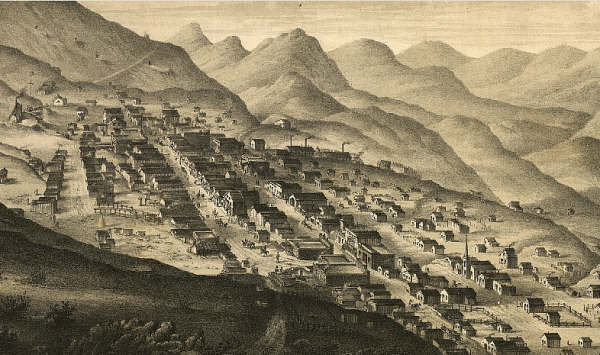
This is how Virginia City Nevada looked in the 1860s when Sam Clemens was a reporter there. As small as it was, Virginia City was one of the largest towns on the west coast.
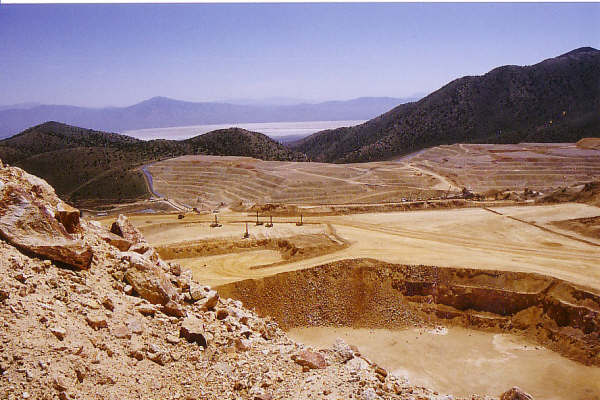
Mark Twain Prospected for silver ore in the Humboldt range of Northern Nevada. Big Mines in that area still produce millions of ounces of silver every year.


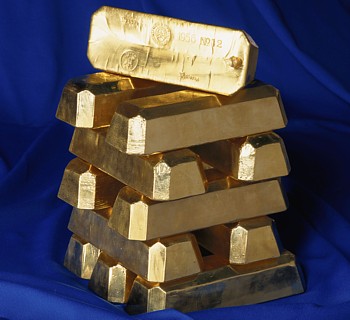
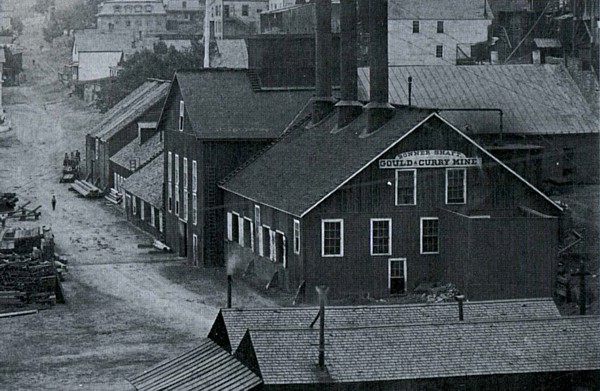
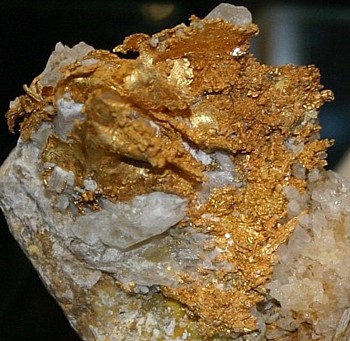
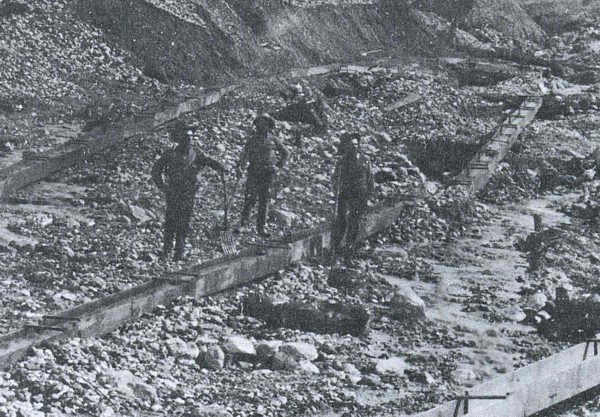
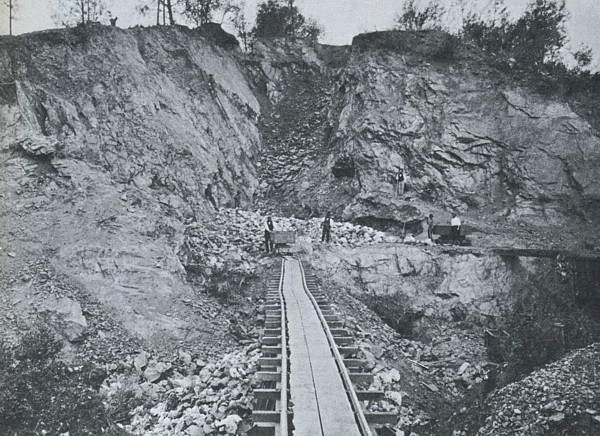
تعليق